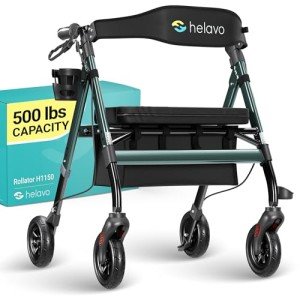The No. #1 Question Everybody Working In Transport Walker Should Know How To Answer
Understanding Transport Walkers: A Comprehensive Guide
Transport walkers are crucial mobility aids created to boost the independence and safety of people, especially the elderly and those with mobility challenges. Combining the performance of a walker with the convenience of a seat, these devices permit users to maintain their mobility while supplying a resting choice whenever required. In this blog post, we check out the features, benefits, types, and upkeep of transport walkers, along with frequently asked concerns to gear up readers with essential knowledge.
What is a Transport Walker?
Transport walkers are mobility devices geared up with wheels created for individuals with mobility challenges. Unlike conventional walkers, which need users to raise them somewhat to move, transport walkers include wheels that help with rolling. They typically consist of a seat, handlebars for stability, and a storage basket for personal products.
Secret Features of Transport Walkers
- Wheeled Base: The rolling wheels permit easy motion, decreasing the strain on the user.
- Foldable Design: Most transport walkers can be easily folded for storage or transport.
- Comfortable Seating: A padded seat is normally integrated, supplying users a location to rest.
- Hand Brakes: Designed for safety, many walkers include hand brakes that enable users to manage their speed and maintain stability.
- Storage Options: An integrated basket or pouch at the front enables users to bring personal products without the need for extra bags.
Advantages of Using Transport Walkers
Transport walkers offer many benefits that accommodate the needs of various users:
1. Increased Mobility
Transport walkers enable individuals to navigate their areas more easily. They are especially useful for those recovering from surgery or dealing with chronic health problems.
2. Safety and Stability
With a sturdy frame and supportive handlebars, transport walkers provide stability, reducing the threat of falls and accidents.
3. Resting Capability
The seating choice offers users an opportunity to rest during extended getaways, which is essential for those who may tire easily.
4. Easy Maneuverability
Transport walkers are lightweight and developed for smooth movement, making them easy to utilize both indoors and outdoors.
5. Independence
By utilizing transport walkers, people can take part in activities without relying heavily on caretakers, thus boosting their self-reliance and lifestyle.
Kinds Of Transport Walkers
When considering a transport walker, it's crucial to acknowledge the different types readily available:
Type
Description
Requirement Transport Walker
Basic model with four wheels and a seat.
Transport Wheelchair
Combines the functions of a walker and a wheelchair. Can be pressed by a caregiver.
Heavy-Duty Transport Walker
Created for larger users, supplying additional stability and weight capacity.
Two-Wheel Walker
Features 2 wheels at the front and two back legs, enabling for much better balance.
Reclining Walker
Provides adjustable seating for comfort, targeting users with unique needs.
How to Choose the Right Transport Walker
Factors to Consider:
- User's Height: Ensure that the walker is adjustable to the user's height for optimal convenience and safety.
- Weight Capacity: Check the walker's weight limit to guarantee it can accommodate the user.
- Planned Use: Determine if the walker will be used mostly indoors, outdoors, or both.
- Storage Features: Evaluate the benefit of storage alternatives readily available with the walker.
- Portability: If routine transport of the walker is essential, consider its weight and how easily it can be folded.
Maintenance Tips for Transport Walkers
To lengthen the life and efficiency of a transport walker, follow these upkeep pointers:
- Regular Cleaning: Wipe down the frame and seat with a wet cloth to get rid of dirt and discolorations.
- Check the Wheels: Ensure the wheels are rolling efficiently; oil if essential.
- Examine Brakes: Regularly examine that hand brakes work properly for added safety.
- Tighten Up Bolts and Screws: Periodically inspect and tighten up any loose parts.
- Change Parts As Needed: If wheels or footrests show indications of wear, consider changing them for ideal safety.
Often Asked Questions (FAQs)
1. Who can benefit from a transport walker?
Transport walkers are ideal for older adults, people recovering from surgical treatments, and those with conditions such as arthritis, stroke, or balance problems.
2. Are transport walkers appropriate for outdoor usage?
Yes, many transport walkers are developed with durable products and wheels that can handle outdoor surface, although it's best to examine manufacturer specs.
3. How much weight can a transport walker generally deal with?
Many transport walkers have weight capacities ranging from 250 to 400 pounds, depending upon the brand name and design.
4. Do I need a prescription to purchase a transport walker?
While a prescription is not generally needed to buy a transport walker, seeking advice from a health care provider can assist in selecting the best walker for specific needs.
5. Can transport walkers be used by people with minimal upper body strength?
Yes, numerous designs are developed with features that supply stability and make them easier to use for individuals with restricted upper body strength.
Transport walkers are invaluable aids that promote self-reliance, safety, and mobility for individuals with mobility challenges. By understanding their features, advantages, and maintenance, users can pick the ideal walker to suit their way of life. Purchasing a transport walker can make a substantial difference in enhancing one's lifestyle, making day-to-day activities more workable. Whether used for Rollator Walker or longer adventures, a transport walker supplies the support and confidence required to browse the world.
